|
|
|
ARSHILE GORKY |
|
|
|
"Abstraction allows man to see with
his mind what he cannot physically see with his eyes...
Abstract art enables the artist to perceive beyond the
tangible, to extract the infinite out of the finite. It is
the emancipation of the mind. It is an explosion into
unknown areas... The stuff of thought is the seed of the
artist. Dreams form the bristles of the artist's brush. As
the eye functions as the brain's sentry, I communicate my
innermost perceptions through the art, my world view..."
"Drawing is the basis of art. A bad
painter cannot draw. But one who draws well can always
paint... Drawing gives the artist the ability to control his
line and hand. It develops in him the precision of line and
touch. This is the path toward master work."
Arshile Gorky (1904 – 1948). |
| |
|
|
Arshile Gorky was one of the
most influential American artists of the 20th century.
"When Arshile Gorky died in 1948,
America lost one of her outstanding modern painters -- a man
who opened the path for the avant-garde of our day and who
achieved, in his own art, a last brilliant flowering of
extraordinary power and beauty." Ethel Schwabacher, 1957.
"The forties witnessed Gorky's emergence as a major and
innovative figure in American painting, even as his tragic
life moved relentlessly toward catastrophe. Only in that
last phase of his creative life does Gorky emerge powerfully
in his own terms and speak to us through forms that are
uniquely his..." Thomas Messer, 1981.
"Arshile Gorky was an unabashedly ambitious artist,
'apprenticing' himself to a series of masters - most notably
Cezanne and Picasso - in order to become, at last, the
master of his own personal style. His transformation of
traditions into an utterly untraditional approach in turn
inspired the Abstract Expressionists, who achieved a fame
that Gorky died too young to enjoy..." Melvin P. Lader,
1985.
"He was one of the first artist to
truly liberate formal elements of painting. Gorky's
influence on the development of de Kooney and Pollock was
profound, and throughout the evolution of their work, each
had an immeasurable affect not only on the course of
American Art, but on that of the entire Twentieth
century..." Gerald Peters, 1990.
"Gorky pioneered a complex vocabulary of forms by fusing
landscapes remembered from his childhood home in Armenia
with surrealist imagery and abstract plumes of color. In so
doing,
|
|
he helped create a
distinctly new vision for painting, leading American art
into one of the most experimental periods in its history."
Arshile Gorky, The Breakthrough Years, Auping, 1995.
"Arshile Gorky, one of the most intriguing figures in modern
art, was at the center of the New York art world in the
twenties, thirties, and forties. Yet he
was never fully recognized as an important painter in his
lifetime, and it was only after his death that his
reputation soared..." From A High Place. Spender, 1999.
"One of the first abstract expressionists, he was a major
influence on the New York art scene, which included de
Kooning, Rothko, Pollock, and others..." Black Angel ,
Matossian, 2000.
By
the early forties, Gorky had entered his most fruitful
period and developed the style that is seen as the link
between European modernism and American abstract
expressionism. His masterpieces influenced the great
generation of American painters in the late forties, even as
Gorky faced a series of personal catastrophes..."Arshile
Gorky. His Life And Work, Herrera, 2003.
Charles Moffat went as far as calling him the "Father of
Abstract Expressionism." December 2007.
I was introduced to Arshile Gorky while taking art classes
in college. Encouraged to study the work of Gorky, I found
his work intriguing, inspiring, animated, spontaneous,
vigorous, forceful, impelling and assertive. As Gorky had
schooled himself in Cezanne and Picasso, I began
schooling myself in Gorky. Time passed, by my admiration for
the work of Arshile Gorky never faded. His paintings and
drawings hang in every major museum in American. I always
found myself seeking out the work of Arshile Gorky.
|
|
|
|
|
BOOKS
ART |
|
|
|
ARSHILE GORKY
BOOKS
|
|
|
|
|
1951
1957 1962
1970 1975 1978
1980
1981 1985
1990 1991
1994 1995
1999 2000
2003 2004
2009 2010
2019
|
|
|
|
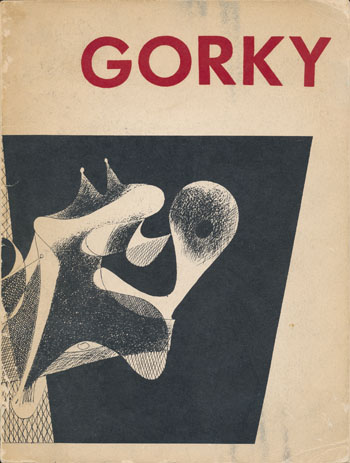 |
Date:
1951
Title:
Arshile Gorky. Memorial Exhibition (Soft Cover) (Published by
Whitney Museum of American Art, New York)
Author:
Schwabacher, Ethel; Goodrich, Lloyd
Description:
Published in conjunction with an exhibition held at the Whitney
Museum of American Art, New York, January 5 to February 18,
1951; Walker Art Center, Minneapolis, March 4 to April 22, 1951;
San Francisco Museum of Art, San Francisco, May 9 to July 9,
1951. "Arshile Gorky, born in Armenia and coming to America at
the age of sixteen, liked to think of himself as part of a
Caucasian heritage which retained elements of ancient Sumerian
culture. Lake Van, where he lived as a child, had been the
center of an Armenian civilization which held memories of
Semiramis and the Babylonian kings, and had celebrated schools
of calligraphy and illuminated manuscripts. Doubtless Gorky had
seen these works, which were enriched with fantastic and
delightful forms of hybrid animals and men suggestive of recent
surrealism. Raised in the mountains of northern Armenia and the
Caucasus, of peasant ancestry on his fathers side, and a long
line of priests on his Georgian mothers, Gorky was a man of
great physical vigor and creative passion..." Includes 1
portrait of Arshile Gorky by Gjon Mili, 1946 and 25 examples of
his work. (First Edition)
Size:
7.5 x 10
Pages: Pp 50
ST#:
1951.01.12.18 |
|
|
|
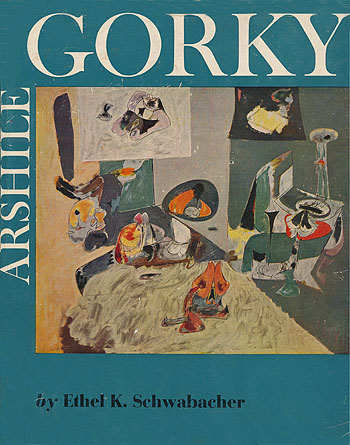 |
Date:
1957
Title:
Arshile Gorky (Hard Cover DJ) (Published for the Whitney Museum
of American Art by The Macmillan Company, New York)
Author:
Schwabacher, Ethel K.; Preface by Lloyd Goodrich, Introduction
by Meyer Schapiro
Description: Dust jacket: "When
Arshile Gorky died in 1948, America lost one of her outstanding
modern painters -- a man who opened the path for the avant-garde
of our day and who achieved, in his own art, a last brilliant
flowering of extraordinary power and beauty. The ‘wild and
tender’ personality of Gorky – in Andre Breton’s words – emerges
vividly and this sensitive biography by his pupil and close
friend, Ethel K. Schwabacher. It is, in the best sense, and
intimate biography, revealing the material temperament, the
intense emotional crisis, the theatrical exaggerations and the
true heroism of the man. But it is more than that; it is also a
fascinating record of Gorky’s poetic and brilliant talk about
art, obvious methods of painting, of the genius of those
obsessive images which reappear in many of his paintings, and an
explanation – insofar as that is possible – of their symbolic
meaning to the artist..." Original list price $8.50. (First
Edition)
Size:
9 x 11.25
Pages: Pp 159
ST#:
1957.02.0219 |
|
|
|
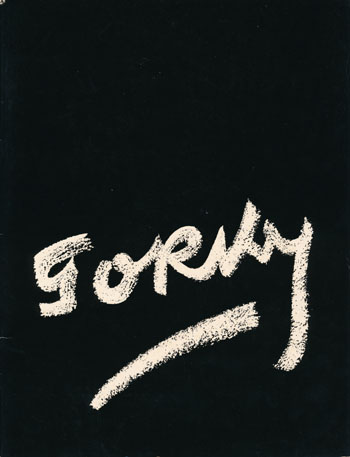 |
Date:
1957
Title:
Gorky: 33 Paintings by Arshile Gorky (Soft Cover) (Published by
the Sidney Janis Gallery, New York)
Author: Janis,
Sidney
Description: Published in conjunction with
an exhibition at the Sydney Janice Gallery, December 2 through
28, 1957. "For its 3rd Exhibition of the work of Arshile Gorky
and held to coincide with the publication of the book by Mrs.
Ethel Schwabacher on the artist’s life and art, the Sydney Janis
Gallery presents a selection of many Gorky’s outstanding
paintings of the period of 1930 to his death in 1948. Thanks are
due to the author and to Miss Rosalind Irving, Associated
Curator of the Whitney Museum of American Art for their kind
assistance..." Includes 1 portrait of Arshile Gorky by Gjon Mili,
1946, 36 examples of his work and 4 photographs of past
exhibitions. (First Edition)
Size:
8.5 x 11
Pages: Unpaginated (Pp 20)
ST#:
1957.01.0681 |
|
|
|
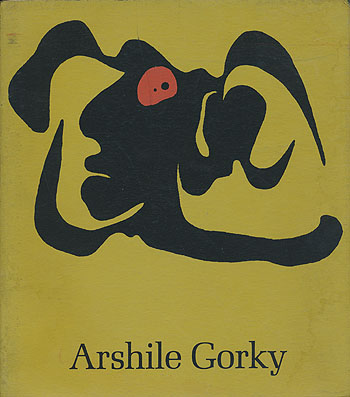 |
Date:
1962
Title:
Arshile Gorky. Paintings, Drawings, Studies (Soft Cover)
(Published by The Museum of Modern Art, New York in
collaboration with The Washington Gallery of Modern Art)
Author:
Seitz, William Foreword by Julien Levy
Description:
Published in conjunction with an exhibition at The Washington
Gallery of Modern Art, March 12, 1962 and The Museum of Modern
Art, New York, December 17, 1962. Foreword: "From poverty, or of
a piece with his camouflage, for he was a very camouflage man,
Arshile Gorky as long as I knew him wore a patched coat, either
an old tweet jacket with leather elbow pads in summer or in
winter a ragged overcoat much too long for even his tall and
lean frame. Inside his overcoat he would draw himself up, or
lower himself without bending, so when he crouched, perhaps to
examine a canvas, his coat crumpled down like an accordion as he
folded his legs beneath it with the same muscles used by
Caucasian dancers - although Gorky was not Caucasian, was in
fact Armenian, and Gorky was not his real name..." Includes 1
portrait and 82 examples of Gorky’s work. (First Edition)
Size:
8.5 x 9.5
Pages: Pp 56
ST#:
1962.01.0580 |
|
|
|
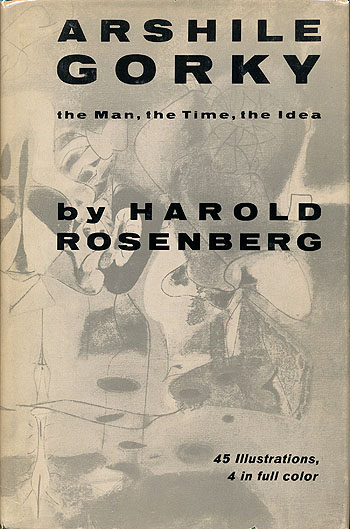 |
Date:
1962
Title:
Arshile Gorky. The Man, The Time, The Idea (Horizon HC)
(Published by Horizon Press, Inc., New York)
Author:
Rosenberg, Harold
Description: Dust jacket:
"Writing with an intimate knowledge of Gorky both as a person
and as artist, and of the influence of his work today, Harold
Rosenberg says: ‘By whatever measure one ranks the founders of
contemporary abstract art, Arshile Gorky has a place on the top
row.’ In this model kind of study of an artist, the author of
the renowned ‘The Tradition of the New’ presents this pioneer of
the new American painting in a master blending a biographical
portrait and penetrating interpretation..." 45 Illustrations, 4
in full color. Original list price $3.75. (First Edition)
Size:
5.5 x 8.5
Pages: Pp 144
ST#:
1962.03.0219 |
|
|
|
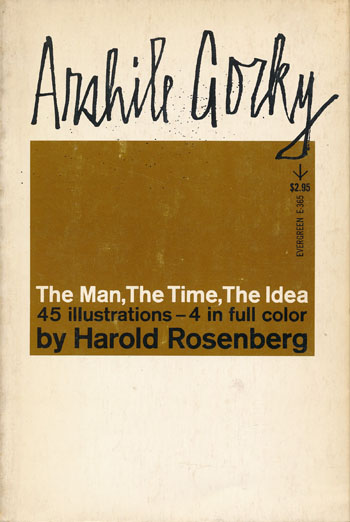 |
Date:
1962
Title:
Arshile Gorky. The Man, The Time, The Idea (Soft Cover)
(Published by Grove Press, Inc., New York)
Author:
Rosenberg, Harold
Description: Back cover: "By
whatever measure one ranks the founders of contemporary abstract
art," writes Harold Rosenberg, "Arshile Gorky has a place on the
top row." Gorky, he asserts, stands for the importance of
intellect in painting -- a figure contradicting the popular
image of the abstract impressionist artist as a whirling dervish
of automation and wild inspiration. In tracing Gorky’s
development, Rosenberg discusses the social and political
background of the painter’s life and thought, from his embattled
apprenticeship in Greenwich Village through his sudden rise to
fashionable Connecticut and the international art set, to his
end in suicide motivated by illness, jealousy, and despair, in
1948... Original list price $2.95. (First Edition)
Size:
5.5 x 8
Pages: Pp 144
ST#:
1962.02.0219 |
|
|
|
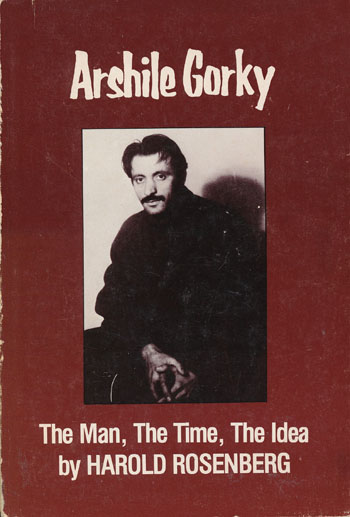 |
Date:
1981
Title:
Arshile Gorky. The Man, The Time, The Idea (Soft Cover)
(Published by The Sheepmeadow Press/Flying Point Books, New York
City)
Author: Rosenberg, Harold
Description:
Back cover: "Arshile Gorky, long out of print, is one of the key
works on which Harold Rosenberg's reputation is based as the
great critic of twentieth century American art. In tracing
Gorky’s development, Rosenberg discusses the social and
political background of the painters life and thought, from his
embattled apprenticeship in Greenwich Village through his sudden
rise to fashionable Connecticut and the international art set,
to his end in suicide motivated by illness, jealousy, and
despair, in 1948...." Original list price $4.95/5.95.
(First Edition)
Size:
5.5 x 8
Pages: Pp 144
ST#:
1981.03.0219 |
|
|
|
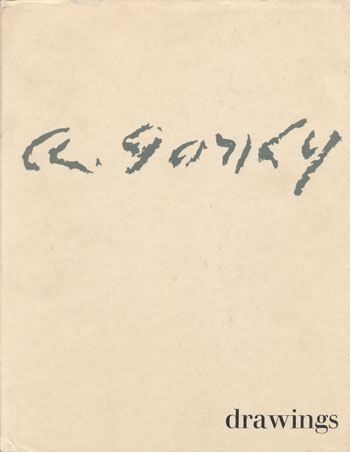 |
Date:
1970
Title:
Gorky Drawings (Hard Cover DJ) (Published by Walker-Knoedler
Books, New York)
Author: Walker-Knoedler Books
Description:
Dust jacket: "Arshile Gorky was one of the most influential
American artists of the 20th century. 22 of his drawings are
produced in this volume, all but one being published for the
first time. They fully reveal Gorky’s strength and sensibility
as a draftsman and are further evidence of the themes that
pre-occupied him throughout his career. These facsimiles have
been made with meticulous fidelity to the originals, and will
serve as an important record for all those concerned with
contemporary art." Includes 22 plates printed single sided of
Gorky’s. Original list price $6.95. (First Edition)
Size:
9 x 11.25
Pages: Unpaginated (Pp 47)
ST#:
1970.01.0680 |
|
|
|
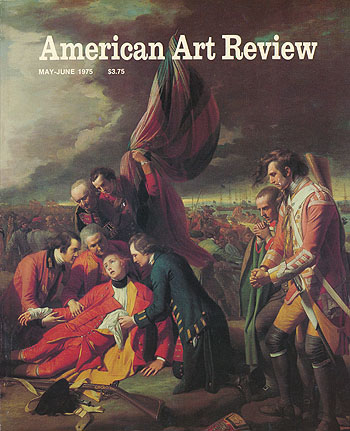 |
Date:
1975
Title:
American Art Review - May-June 1975 (Published
Bi-monthly by the Kellaway Publishing Company, Los
Angeles, CA)
Author:
Gorky, Arshile
Description:
"Stuart Davis, 1931 ...Yet the
silent consequences of Stuart Davis moves us to the cool and
intellectual world we're all human emotions are disciplined
upon rectangular proportions. Here these relations take us
to the scientific world where all dreams evaporate and logic
plays its greatest victory, where the physical world
triumphs over all tortures, where all clumsiness dies, and
leaves only the elements of virtue, where the
aesthetic world takes new impulse for new consequences..."
Includes one illustration by Davis and two by Gorky.
Size:
8.5 X 11
Pages:
Pp 124-126
S#:
1994.00.0620 |
|
|
|
 |
Date:
1978
Title:
Arshile Gorky Adoian (Hard Cover DJ) (Published by Gilgamesh
Press Limited, Chicago)
Author: Mooradian, Karlen
Description:
Written by Gorky’s nephew, son of the artist’s sister. Dust
jacket: "The worlds leading authority and most prolific writer
on Arshile Gorky here presents the most complete book ever
written on the 20th century master and establishes him as the
founder of the modern hylozoism. A scholarly study long overdue
on the greatest artist in U.S. history and among the finest in
the long annals of Armenian and world art. Based on 23 years of
research, the book consists entirely of primary source
materials, both Armenian and western, available only to the
author: Gorky’s own correspondence and dissolution from 4,000
pages of transcribe interviews conducted by the writer with more
than 100 artists, relatives, friends and enemies in Armenia, the
near East, Russia, Europe in the United States..." Includes 162
photographs and examples of Gorky’s work. (First Edition)
Size:
6 x 9.25
Pages: Pp 314
ST#:
1978.01.1218 |
|
|
|
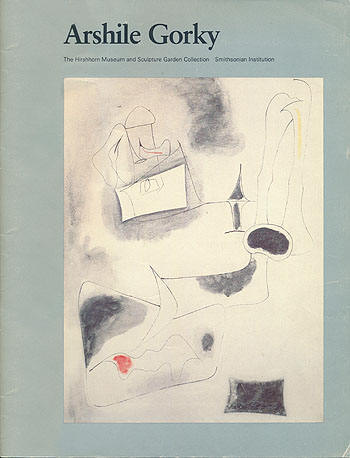 |
Date:
1978
Title:
Arshile Gorky, The Hirshhorn Museum and Sculpture Garden
Collection, Smithsonian Museum (Soft Cover) (Published by the
Smithsonian Museum, Washington D. C.)
Author:
Rosenzweig, Phyllis
Description: Introduction:
"At some elusive moment in the late 1940s, American vanguard
artists stopped looking only to Europe for direction and began
evolving an art that was distinctively American. ArshileGorky
was a central figure in that transition. Gorky bridged several
worlds. While he was committed to mastering the most advanced
concepts of western art, he maintained a deep and abiding
identity with a Traditional culture of his native Armenia. In
the late 1920s and ‘30s he associated with an inner circle of
advanced artists, including Stuart Davis, John Graham, and
William deKooning, who responded primarily to the current
innovations in Paris. At the same time, he also kept ties with
more traditional figurative artists like Raphael Soyer and David
Burliuk... By exhibiting and documenting the museums entire
collection of works by Arshile Gorky, we hope to illuminate the
development of this fascinating artist as well as to present
work that will be enjoyed for its own beauty and value." The
Hirshhorn Museum and Sculpture Garden is an art museum beside
the National Mall, in Washington, D.C. and is part of the
Smithsonian Institute. The museum was initially endowed during
the 1960s with the permanent art collection of Joseph H.
Hirshhorn. Includes 29 examples of Gorky’s work as well as an
extensive description for each. (First Edition)
Size:
8.5 x 11
Pages: Pp 47
ST#:
1978.02.1218 |
|
|
|
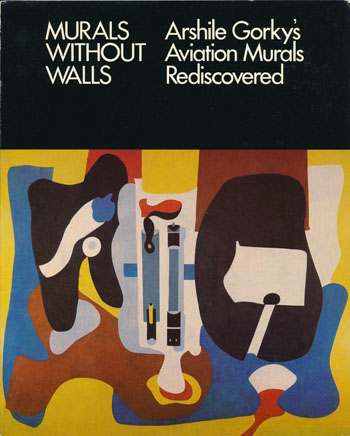 |
Date:
1978
Title:
Murals Without Walls. Arshile Gorky’s Aviation Murals
Rediscovered (Soft Cover) (Published by The Newark Museum,
Newark, New Jersey)
Author: Bowman, Ruth.
Foreword: Miller, Samuel C. Essays by: Arshile Gorky; Francis V.
O’Connor; Frederick T. Kiesler; Ruth Bowman; Jim M. Jordon
Description:
Published in conjunction with an exhibition at Newark Museum
November 15, 1978-March 11, 1979, and The American Federation of
Arts Tour, July 1979-December 1980. Foreword: "It is most
appropriate that Murals Without Walls should originate in the
Newark Museum. In 1932 a major exhibition on aviation was held
here to celebrate the that Newark was the center of modern
aviation in America. In May of 1935, at a time of the dedication
of the new Administration Building at the Newark Airport, the
government was embarking on the WPA Federal Art Project. Through
the initiative of Beatrice Windsor, director of the Newark
Museum from 1929 to 1947, WPA artists were to be employed to
create work for the new airport building. During that time that
Gorky’s model and full-size panel of one of the airport murals
we're on exhibition at the Newark Museum , Newark’s Mayor
Ellenstein created a five-member art commission on November 12,
1936, appointing Miss Windsor to a three-year term..." Includes
numerous photograph and 35 examples of Gorky’s work. Original
list price $7.95. (First Edition)
Size:
8.5 x 10.5
Pages: Pp 96
ST#:
1978.03.1218 |
|
|
|
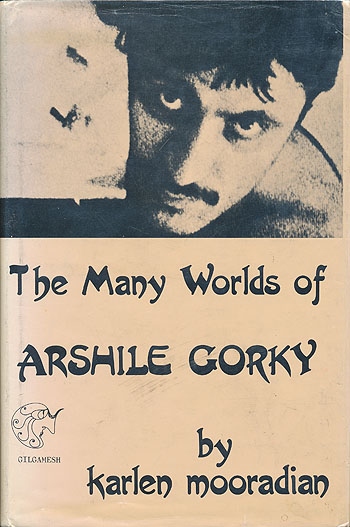 |
Date:
1980
Title:
The Many Worlds of Arshile Gorky (Hard Cover DJ) (Published by
Gilgamesh Press Limited, Chicago, Illinois)
Author:
Mooradian, Karlen
Description: Dust jacket: "There
are many Gorkys. The Gorky of portraits and abstractions. The
laughing, weeping, dancing, fighting Gorky of doubts and
confidence. The Gorky who knocks out opponents on New York
streets and saves bird chicks in Armenia. The Gorky of death
marches holding the limp body of his mother who has died in the
Turkish genocide of the Armenians. Lastly, the epic Gorky who,
battling the knights of fire, cancer, injuries and marital
problems, turns his sword against modern society and dangles by
the neck from a rope on a Connecticut hillside, seeking his
native land, "The dot of birth, the dot of birth." The many
worlds of Arshile Gorky is a documentary montage containing the
largest body of original Gorkian source materials yet assembled
in a single volume, the product of 25 years of research
conducted by Professor Mooradian. Indispensable to understanding
Gorky and his art." Includes 70 illustrations. (First
Edition)
Size:
6 x 9.25
Pages: Pp 327
ST#:
1980.01.0219 |
|
|
|
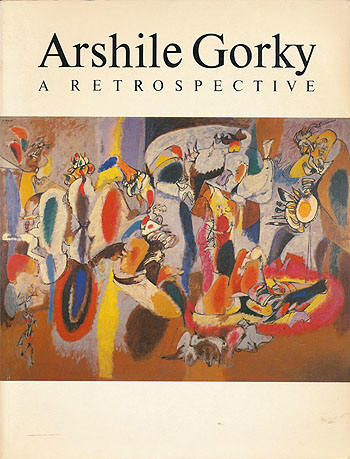 |
Date:
1981
Title:
Arshile Gorky. 1904-1948, A Retrospective (Soft Cover)
(Published by Harry N. Abrams, Inc., New York, in collaboration
with The Solomon R. Guggenheim Museum, New York)
Author:
Waldman, David; Preface by Thomas M Messer
Description:
Published in conjunction with an exhibition at The Guggenheim
Museum, April 24 - July 19, 1981. Preface: "Arshile Gorky, seen
as the end product of a historical evolution, becomes the last
link in a chain of modern painters who have compelled our vision
since the late nineteenth century. But at the same time and not
inconsistent with such a view, we endow Gorky today with the
attributes of a pioneer. For it was his painterly insights and
attributes that helped shape the generation of Americans who,
having waged their first decisive battles at about the time of
his death, were carried to prominence and victory in the 1950s
as the martyrs or heroes of the New York School. Equipped with a
native poetic talent which searched for visual equivalents,
Gorky subjected himself in the twenties and thirties to a
schooling that consisted of conscientious imitation of the
modern masters and of a deliberate avoidance of self-assertion
and original expression. The forties witnessed Gorky's emergence
as a major and innovative figure in American painting, even as
his tragic life moved relentlessly toward catastrophe. Only in
that last phase of his creative life does Gorky emerge
powerfully in his own terms and speak to us through forms that
are uniquely his..." Includes 250 plates of Gorky’s work. A
chronology of his life and exhibitions during his life time, to
numerous to list here. 12,000 copies of this catalogue printed
in four color offset and gravure. (First Edition)
Size:
8.5 x 11
Pages: Pp 285
ST#:
1981.01.0685 |
|
|
|
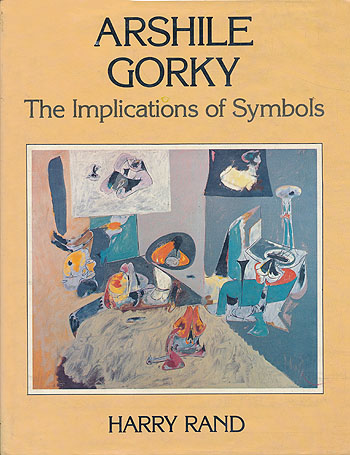 |
Date:
1981
Title:
Arshile Gorky. The Implication of Symbols (Hard Cover DJ)
(Published by Allanheld, Osmun & Co., Publishers, Inc.,
Montclair, New Jersey)
Author: Rand, Harry
Description:
Dust jacket: "Often considered either the last of the
Surrealists or the harbinger of Abstract Expressionism, Gorky
played a crucial role in ushering the modernist impulse into the
American art. The author recounts the artist's brief and
troubled life and traces his artistic development from the early
murals and other works painted during the Depression to his
mature works of the 1940s and his death in 1948. Through close
study of an oeuvre usually assumed to be non-representational in
its mature period, the author has deciphered an iconography
revealing the unexpected and systematic use of explicit ideas,
symbols and commonplace objects, settings, and persona from the
artist's life. His mature work may in fact be seen in part as an
attempt to create a concealed ‘history’ of himself. All of
Gorky's major themes are touched upon and his major paintings
dealt with in some depth, with attention to the details of the
individual works and, frequently, to the drawings and
preliminary studies from which the paintings evolved. The
discussion is centered on the images that united the pieces and
develop from work to work. Their meaning for Gorky is explored,
as well as possible sources and their relationship to the body
of Gorky's art. A concluding chapter reassesses Gorky's impact
on the New York School in light of a new understanding of his
aims and methods." Includes 141 B&W and 5 color illustrations.
(First Edition)
Size:
8.5 x 11.25
Pages: Pp 246
ST#:
1981.02.0219 |
|
|
|
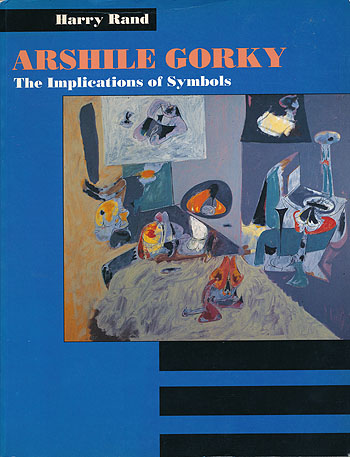 |
Date:
1991
Title:
Arshile Gorky. The Implication of Symbols 1991 (Soft Cover)
(Published by University of California Press, Berkeley, Los
Angeles, Oxford)
Author: Rand, Harry
Description:
First published in 1981 by Allanheld & Schram, Montclair, N.J.
Publisher’s description: "Harry Rand's critically acclaimed
study of Gorky's brief, troubled life and artistic development
is finally available in paperback. All of Gorky's major themes
are touched on and his major paintings dealt with in some depth,
with attention to the details of the individual works, and
frequently to the drawings and preliminary studies from which
the paintings evolved. The discussion centers on the images that
united the pieces as they develop from work to work. Rand
explores Gorky as well as possible sources and their
relationship to the body of Gorky's art. A concluding chapter
reassesses Gorky's impact on the New York School in light of a
new understanding of his aims and methods. Through close study
of Gorky's oeuvre, the author deciphers an iconography revealing
the unexpected and systematic use of explicit ideas and symbols
as well as commonplace objects, settings, and personas from the
artist's life. Includes 163 photographs and examples of Gorky’s
work. (First Edition)
Size:
8.5 x 11
Pages: Pp 277
ST#:
1991.01.1218 |
|
|
|
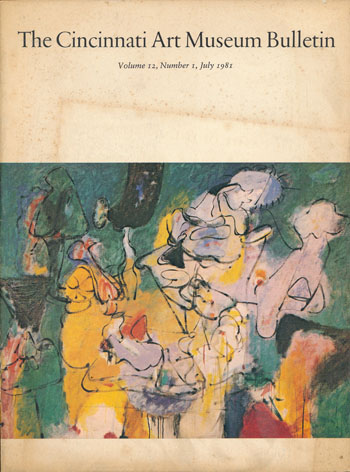 |
Date:
1981
Title:
The Cincinnati Art Museum Bulletin July 1981 (Published by the
Cincinnati Art Museum, Cincinnati, Ohio)
Author:
Schoellkopf, Carol M.
Description: Cover
illustration: Arshile Gorky, 1904-1948, American, "Virginia
Landscape, 1944, Oil on canvas. Acquired in 1979. Page 32:
Arshile Gorky, 1904-1948, American, "Virginia Landscape, 1944,
Oil on canvas. Acquired in 1979.
Size:
7.5 x 10
Pages: Pp 45
ST#:
1981.04.0219 |
|
|
|
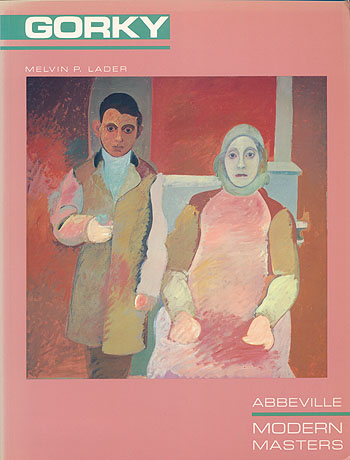 |
Date:
1985
Title:
Arshile Gorky (Soft Cover) (Published as part of the Modern
Masters Series by Abbeville Press, New York, London, Paris)
Author:
Lader, Melvin P.
Description: Back cover: "Arshile
Gorky was an unabashedly ambitious artist, 'apprenticing'
himself to a series of masters - most notably Cezanne and
Picasso - in order to become, at last, the master of his own
personal style. His transformation of traditions into an utterly
untraditional approach in turn inspired the Abstract
Expressionists, who achieved a fame that Gorky died too young to
enjoy...Dr. Melvin P. Lader chronicles the artist's life from
his bittersweet youth in Armenia through his precocious
development as an artist and teacher to that long, purposeful
evolution of his mature style." Includes 125 photographs and
examples of Gorky’s work. (First Edition)
Size:
8.5 x 11
Pages: Pp 128
ST#:
1985.01.0690 |
|
|
|
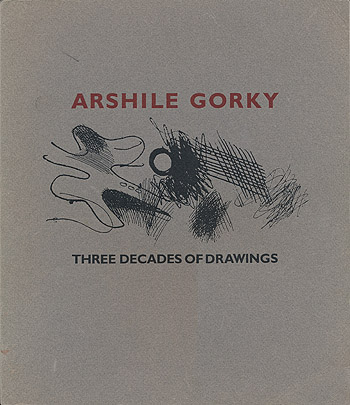 |
Date:
1990
Title:
Arshile Gorky. Three Decades of Drawings (Soft Cover) (Published
by Gerald Peters Gallery in association with John Van Doren, New
York)
Author: Lader, Melvin P.
Description:
Published in conjunction with exhibitions held at Santa Fe,
September 22 - October 4, 1990; Dallas, October 11 - October 31,
1990; New York, November 5 - November 21, 1990. "Drawing is the
basis of art. A bad painter cannot draw. But one who draws well
can always paint... Drawing gives the artist the ability to
control his line and hand. It develops in him the precision of
line and touch. This is the path toward master work." Arshile
Gorky. "It gives us great pleasure to present this group of
drawings by Arshile Gorky. This is the first important
exhibition of Gorky’s work in America in sometime. We are
particularly pleased, therefore, to show this cross-section of
extraordinary works on paper from the Twenties, Thirties and
Forties. This is an opportune time to re-examine and explore
Gorky’s tremendous contribution to the roots of abstract
expressionism in America. He was one of the first artist to
truly liberate formal elements of painting. Gorky's influence on
the development of de Kooney and Pollock was profound, and
throughout the evolution of their work, each had an immeasurable
affect not only on the course of American Art, but on that of
the entire Twentieth century..." Gerald Peters. "Arshile Gorky’s
passion for drawing is well known to anyone acquainted with his
art and life. Stories, which have taken on the aura of myth,
have been told and retold how as a youth in his native Armenia
he loved to draw from nature and how he became enamored with the
fluid calligraphy of Armenian midievil manuscript illustrations;
or how in this country before embarking on the career of an
artist his compulsion to draw got ham fired from his job at the
Hood Rubber Company of Watertown, Massachusetts because he
incessantly scratched on the wooden racks used to transport the
factory’s products..." Includes 31 plates of Gorky’s work.
(First Edition)
Size:
9 x 10.5
Pages: Unp Pp 72
ST#:
1990.01.0219 |
|
|
|
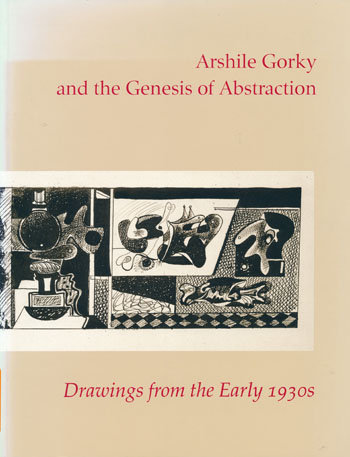 |
Date:
1994
Title:
Arshile Gorky and the Genesis of Abstraction. Drawings from the
Early (Soft Cover) (Published by Stephen Mazoh & Company., Inc.,
New York. Distributed by tyhe University of Washington Press,
Seattle and London)
Author: Spender, Matthew /
Rose, Barbara; With essays by Melvin P. Lader; Joseph P. Ruzicka,
Martin Kline, Sarah E. Lawrence
Description:
Published in conjunction with an exhibition at The Art Museum,
Princeton University, October 29, 1994-January 3, 1995;
Milwaukee Art Museum, January 20-April 16, 1995; The Baltimore
Museum of Art, October 18, 1995-January 21, 1996. Foreword:
"This exhibition and accompanying catalogue includes thirty-nine
drawings, many neither shown nor published before, that display
the richness of Arshile Gorky’s production as a draftsman over
several years crucial to his development. This show offers a
rare look at a singularly creative moment of Gorky. With pen and
ink, pencil and paper as the primary vehicles of expression, he
explores and develops a broad abstract visual vocabulary.
Documenting the emergence of Gorky’s unmistakably unique and
intensely personal pictorial language, the exhibition examines
the complex relationship among six themes developed in these
drawings and their eventual connection to Gorky’s 1934 proposal
proposed mural project for the Public Works of Art Project
(PWAP)..." Includes 39 plates as-well-as 26 additional
illustrations related to the work of Arshile Gorky. (First
Edition)
Size:
9.25 x 11.5
Pages: Pp 85
ST#:
1994.01.0219 |
|
|
|
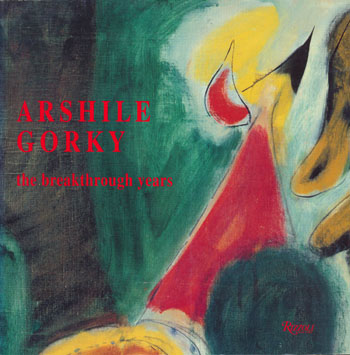 |
Date:
1995
Title:
Arshile Gorky, The Breakthrough Years (Soft Cover) (Published by
Modern Art Museum of Fort Worth, Texas, in association with
Rizzoli, New York)
Author: Auping, Michael; Essays
by: Dore Ashton, Michael Auping, Matthew Spender; and selected
letters by the artist
Description: Published in
conjunction with an exhibition at National Gallery of Art,
Washington D.C., May 7 - September 17, 1995; Albright-Knox Art
Gallery, Buffalo, New York, October 13 - December 31, 1995;
Modern Art Museum of Fort Worth, Texas, January 13 - March 17,
1996. Publisher’s description: "Arshile Gorky (1904-1948) is
recognized as one of the most crucial and intriguing figures in
the early shaping of Abstract Expressionism. Gorky pioneered a
complex vocabulary of forms by fusing landscapes remembered from
his childhood home in Armenia with surrealist imagery and
abstract plumes of color. In so doing, he helped create a
distinctly new vision for painting, leading American art into
one of the most experimental periods in its history. Gorky's
most important paintings and drawings were executed from 1940
through 1947, powerfully expansive years that many regard as his
breakthrough period. His rich, mature work of these years is the
focus of this illuminating volume, the most comprehensive book
on the subject..." Includes 42 plates of Gorky’s work and a
selected list of exhibitions from 1978 - 1994. (First Edition)
Size:
10 x 9.75
Pages: Pp 188
ST#:
1995.01.0600 |
|
|
|
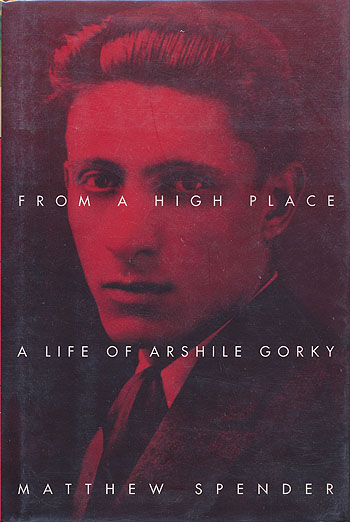 |
Date:
1999
Title:
From A High Place. A Life of Arshile Gorky (Hard Cover DJ)
Published by Alfred A. Knopf, Inc., New York)
Author: Spender, Matthew
Description:
Dust jacket: "Arshile Gorky, one of the most intriguing figures
in modern art, was at the center of the New York art world in
the twenties, thirties, and forties. Yet he was never fully
recognized as an important painter in his lifetime, and it was
only after his death that his reputation soared. In this deeply
felt and penetrating biography, Matthew Spender--himself a
sculptor and the husband of Gorky's elder daughter--writes with
extraordinary sympathy and perception, and he gets to the heart
of his elusive subject... In telling Gorky's story, Matthew
Spender gives us the most illuminating picture of the New York
art scene that has yet been written--from the affluent twenties,
when the Ash Can school was emerging, to the depressed thirties,
which marked the high point of Gorky's career, when he painted a
huge abstract mural for Newark Airport. During the explosive
postwar years, Gorky withdrew into a world of increasing
solitude, even as Andre Breton, the founder of surrealism, was
championing him, along with other artist friends like Willem de
Kooning, Roberto Matta, and Isamu Noguchi..." Includes 108
photographs and examples of Gorky’s work. (First Edition)
Size:
6.5 x 9.5
Pages: Pp 417
ST#:
1999.01.1218 |
|
|
|
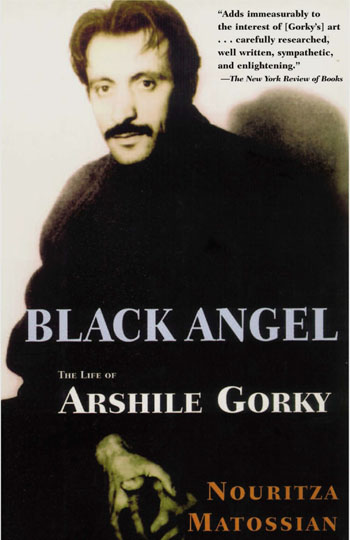 |
Date:
2000
Title:
Black Angel : The Life of Arshile Gorky (Hard Cover) (Published
by The Overlook Press, Woodstock, New York)
Author:
Matossian, Nouritza
Description: Born in Armenia,
he survived the Turkish genocide begun in 1915 and arrived in
America in 1920. One of the first abstract expressionists, he
was a major influence on the New York art scene, which included
de Kooning, Rothko, Pollock, and others. After a devastating
series of illnesses, injuries, and personal setbacks, he
committed suicide at the age of 46. In Black Angel, Nouritza
Matossian uses for the first time Gorky's original letters in
Armenian and other new source material, writing with authority
and insight about the powerful influence Gorky's Armenian
heritage had upon his painting. She also provides an informed
and important critique of the entire body of Gorky's major work.
A powerfully revealing biography of Armenian-born Arshile Gorky
? the Picasso of Union Square, Hollywood Rasputin, magical
storyteller, victim, tragic hero and one of the most mysterious
yet influential of 20th-century artists. Includes 49 photographs
and examples of Gorky’s work. A chronology of his life and
exhibitions during his life time, to numerous to list here.
(First Edition)
Size:
6 x 9.25
Pages: Pp 576
ST#:
2000.01.1218 |
|
|
|
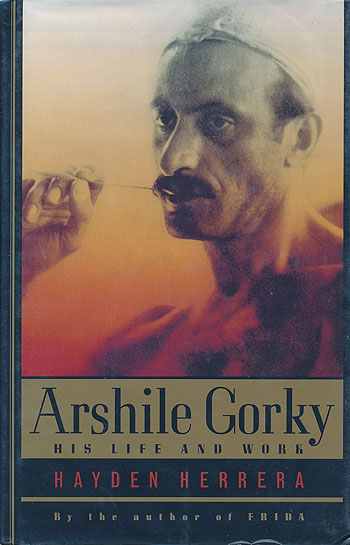 |
Date:
2003
Title:
Arshile Gorky. His Life And Work (Hard Cover DJ) Published by
Farrar, Straus & Giroux, New York)
Author:
Herrera, Hayden
Description: Dust jacket: "Born in
Turkey around 1900, Vosdanik Adoian escaped the massacres of
Armenians in 1915 only to watch his mother die of starvation and
his family scatter in their flight from the Turks. Arriving in
America in 1920, Adoian invented the pseudonym Arshile Gorky-and
obliterated his past. Claiming to be a distant cousin of the
novelist Maxim Gorky, he found work as an art teacher and
undertook a program of rigorous study, schooling himself in the
modern painters he most admired, especially Cezanne and Picasso.
By the early forties, Gorky had entered his most fruitful period
and developed the style that is seen as the link between
European modernism and American abstract expressionism. His
masterpieces influenced the great generation of American
painters in the late forties, even as Gorky faced a series of
personal catastrophes: a studio fire, cancer, and a car accident
that temporarily paralyzed his painting arm. Further demoralized
by the dissolution of his seven-year marriage, Gorky hanged
himself in 1948. A sympathetic, sensitive account of artistic
and personal triumph as well as tragedy, Hayden Herrera's
biography is the first to interpret Gorky's work in depth. The
result of more than three decades of scholarship-and a lifelong
engagement with Gorky's paintings- Arshile Gorky traces the
progress from apprentice to master of the man Andre Breton
called "the most important painter in American history."
Includes 195 photographs and examples of Gorky’s work. (First
Edition)
Size:
6 x 9.5
Pages: Pp 767
ST#:
2003.01 |
|
|
|
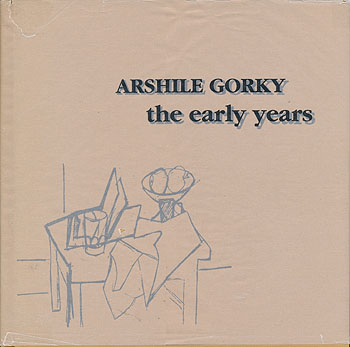 |
Date:
2004
Title:
Arshile Gorky, The Early Years (Hard Cover DJ) (Published by
Jack Rutberg Fine Arts, Inc., Los Angeles, California)
Author:
Lader, Melvin P.; Preface: Rutberg, Jack
Description:
Published in conjunction with an exhibition at Jack Rutberg Fine
Arts, Inc., Los Angeles, California, November 5, 2004 - February
26, 2005. Publisher’s description: "This important text with 96
pages and 103 color illustrations, is devoted to an important
ormative phase of Arshile Gorky's career. Melvin P. Lader,
leading scholar on the artist's work, establishes new critical
ground expanding upon his extensive research and previous
writings on the life and work of Arshile Gorky. With significant
new insights and revelations into his early years, Mel Lader's
essay and Jack Rutberg's preface bring to greater light a
profound artistic relationship between Gorky and artist Hans
Burkhardt, which would have an enduring impact. All of the works
in this book were from Burkhardt's collection, with the majority
of these - more than 100 works - having never before been
exhibited or reproduced." (First Edition)
Size:
9.25 x 9
Pages: Pp 95
ST#:
2004.01.0219 |
|
|
|
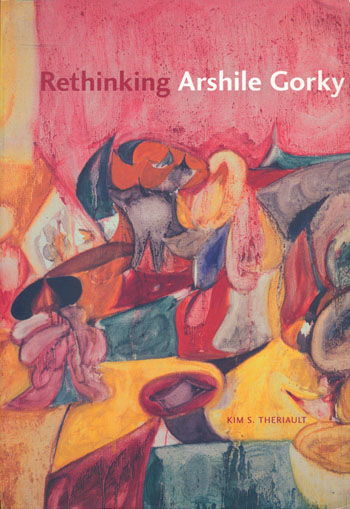 |
Date:
2009
Title:
Rethinking Arshile Gorky (Soft Cover) (Published by The
Pennsylvania State University Press, University Park,
Pennsylvania)
Author: Theriault, Kim S.
Description:
Back cover: "Often referred to as the last Surrealist and first
Abstract Expressionist, Arshile Gorky (c. 1900–1948) appears as
an interstice within art history’s linear progression. Gorky
embraced dream imagery in the tradition of the Surrealists, used
all-over patterning before Jackson Pollock, promoted disembodied
color before Mark Rothko, exploited the physicality of paint
before Willem de Kooning, and anticipated stain painting. His
life—he escaped the Armenian Genocide of 1915 and struggled as
an immigrant artist in New York in the 1930s and 1940s—and his
tumultuous personal relationships have cast the artist as a
tragic figure and often overshadowed the genius of his art.
Rethinking Arshile Gorky is an examination of the artist and his
work based on themes of displacement, self-fashioning, trauma,
and memory. By applying a multitude of techniques, including
psychoanalytic, semiotic, and constructivist analyses, to
explain and demythologize the artist, Kim Theriault offers a
contemporary critique of both the way we construct the idea of
the "artist" in modern society and the manner in which Arshile
Gorky and his art have historically been addressed." Includes 25
color plates and an additional 49 B&W illustrations. (First
Edition)
Size:
7 x 10
Pages: Pp 243
ST#:
2009.01.0719 |
|
|
|
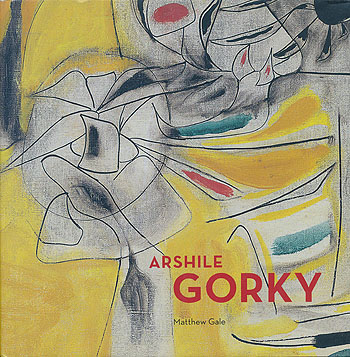 |
Date:
2010
Title:
Arshile Gorky, Enigma and Nostalgia (Hard Cover DJ) (Published
by Tate Publishing, London)
Author: Gale, Matthew
Description:
Published in conjunction with an exhibition at Philadelphia
Museum of Art, October 21, 2009 - January 10, 2010; Tate Modern,
London, February 10 - May 3, 2010; Museum of Contemporary Art,
Los Angeles, June 6 - September 20, 2010. Dust jacket: "Arshile
Gorky (1904-48) is a pivotal figure in mid twentieth century
American painting, providing a bridge between European moderism
and the generation who established the New York School.
Coinciding with a major retrospective exhibition of his work at
Tate Modern (3 February - 3 May 2010), this succinct and
accessible survey examines a career that began and ended with
tragedy but that produced some of the greatest paintings of a
generation. Gorky was born Vosdanik Adoian in Armenia, his
family moving to the city of Van in 1910. When the Turkish army
laid siege to Van in 1914, he took part in its defence,
eventually fleeing 100 miles on foot with his sister and his
mother, who dies of starveation in Eastern Armenia in 1919. In
1920, the artist arrived as a refugee in New York with his
sister, taking his second name from the Russian poet Maxim
Gorky, whose cousin he sometimes claimed to be. He swiftly
turned to art, studying and later teaching at the New School of
Design in Boston. In the 1920s he produced two versions of his
most famous early work, The Artist and his Mother, derived from
a single surviving family photograph. His later style wedded
biomorphic, abstract and surrealist elements, making him a
leading figure in the Abstract Expressionist movement. His
career was cut short by a series of personal tragedies, which
ended with his suicide in 1948." Includes 49 color plates.
Original list price $24.95. (First Edition)
Size:
9.25 x 9.25
Pages: Pp 96
ST#:
2010.02.0219 |
|
|
|
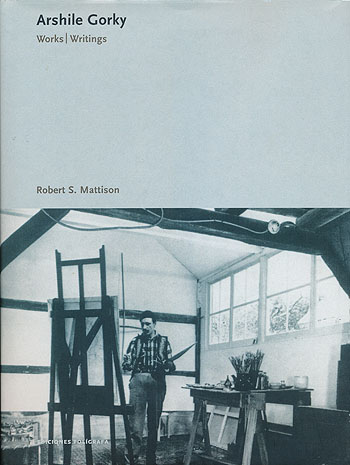 |
Date:
2010
Title:
Arshile Gorky. Works/Writings 2010 (Hard Cover DJ) (Published by
Polígrafa, Ediciones, S. A., Barcelona, Spain)
Author:
Mattison, Robert S.; Goirdy, Arshile; Davis, Stuart
Description:
Dust jacket: "Born on the shores of Lake Van in Armenia, Arshile
Gorky (1904-1948) emigrated to the United States in 1920 where
he established himself as one of the greatest painters of the
period and a seminal figure in the Abstract Expressionist
movement. Although Gorky's life and artistic career were cut
short by his suicide in 1948, the incredible body of work he
left behind, which managed to synthesize Surrealism and the
sensuous colour and mastery of the School of Paris with his own
personal artistic form, secured his reputation as one of the
last great surrealist painters and one of the first abstract
expressionists." Includes 126 photographs and examples of
Gorky’s work. (First Edition)
Size:
8.5 x 11.25
Pages: Pp 159
ST#:
2010.01.1218 |
|
|
|
 |
Date:
2019
Title:
Art & Antiques - June 2019
(Published monthly by Art & Antiques Worldwide Media, LLC., New
York)
Author:
Fensom, Sarah E.
Description:
"Explorer of the New World.
Arshile Gorky, an American refugee,
remade himself in America, the synthesizing and art practice
that brought him to the brink of Abstract Expressionism... The
new Gorky enrolled at the National Academy of Design and the
Grand Central School of Art (where he would eventually
instruct), but was ultimately self-taught. He haunted the halls
of museums and poured over pages of art books and magazines. He
studied El Greco, Pieter Bruegel the elder, and Paolo Uccello
and filled his sketchbook books with examples of Fayum mummy
portraits, Pompeii wall paintings, and Japanese works he
discovered at the Met. "He was inhabiting the point of view,
techniques, and skills of other artists throughout space and
time," says Spender. But this mode of self-pedagogy was so
affective, notes Devaney, not simply because it employed
studying the masters but because of "how well Gorky chose,"
adding that Betty Parsons, one of the last century’s most noted
arbiters of taste, said she had met no one with a more elevated
authenticity of sensibility..." Includes 12 examples of Gorky’s
work. Original cover price $7.99.
Size:
9 x 11
Pages:
Pp 78-87
ST#:
2019.03.0619 |
|
|
|
|
|
|
|
|
|
|
ARSHILE GORKY ART
|
|
|
|
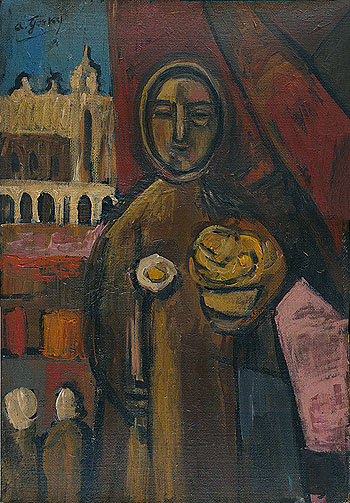 |
Date:
Circa 1930
Title:
Arshile Gorky. "Untitled." Circa 1930. Oil on artist board. 13.5
x 19."
Description: Similar in style to: Still Life with
Skull, Circa 1927-28 (Gorky, Lader, 1985, p.22-23); Cubist Still
Life, Circa 1928–1929; Still Life (Composition No. 7), Circa
1935. (Gorky, Hirshhorn Museum, 1979, p.29.); Image in Khorkom,
Circa 1936-37, (Gorky, Lader, 1985, p.45) Head, Circa 1937;
Still Life, Not Dated, (Arshile Gorky, Works/Writings, Mattison,
2009, p.28). Stamped on verso: "Dresdner Akademie-Studien-Carton..
Schutz- G.&W. D. Marke" ("G.&W. D." with-in an inverted
triangle.) Label pasted to verso: "Rodman’s Art Gallery. A.
Gorky (hand written). William Rodman & Co., Limited. Dealers in
Works of Art. 41, Donegall Place, Belfast." William Rodman
Gallery was in business in Belfast from the 1880's or earlier
until the 1950's. "William Rodman & Co., Dealers in Works of
Art... 41 Donegall Place, Belfast. Donegall Place is a street of
magnificent shops, but we doubt if there is any establishment
among the many notable ones in that fine thoroughfare which
presents a greater wealth of artistic beauty and attractiveness
in its contents, than the well known fancy warehouse of Messrs
Rodman & Co. This eminent house was founded upwards of twenty
five years ago by its present sole principal Mr. William Rodman,
and it has gained a recognized position as the leading
establishment in Belfast for the supply of the highly artistic
goods in which its specialty consists..." "The Industries of
Ireland, Part I: Belfast." Historical Publishing Company, London
and at Edinburgh, Birmingham and Belfast, 1891. Provenance:
William Rodman & Co. Belfast. Signed upper left: "A. Gorky."
Size:
13.5 x 19."
ST#:
1930.01.1218 |
|
|
|
|
Arshile Gorky: Study of "Untitled." |
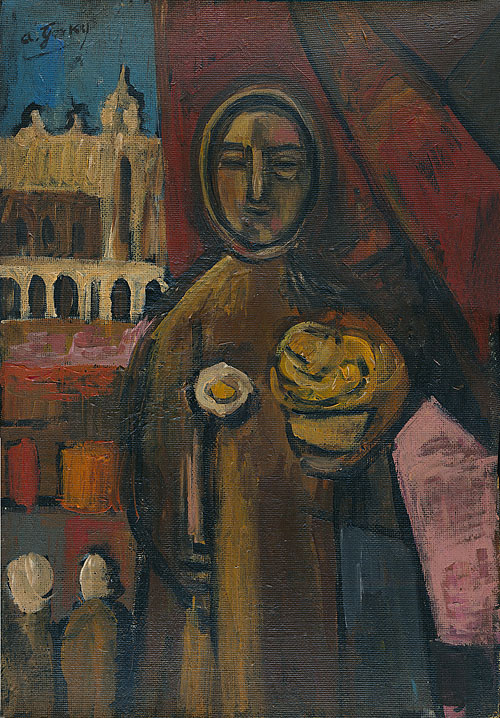 |
|
|
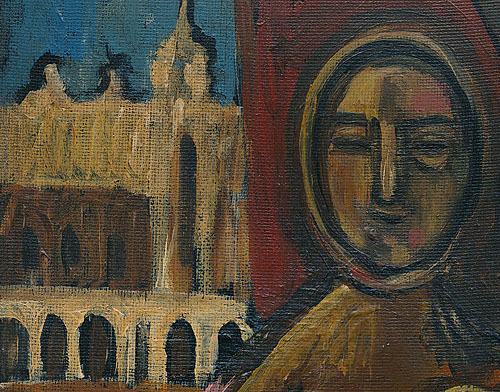 |
|
|
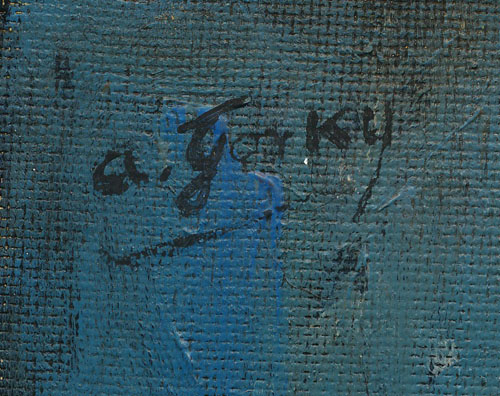 |
|
|
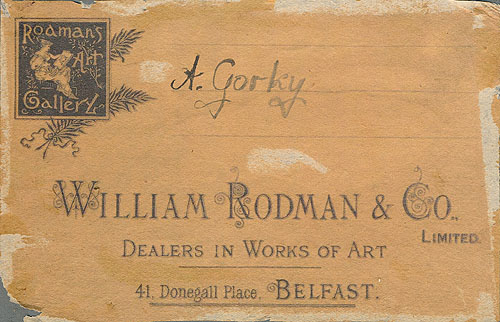 |
|
|
|
|
|
|
|
|
|
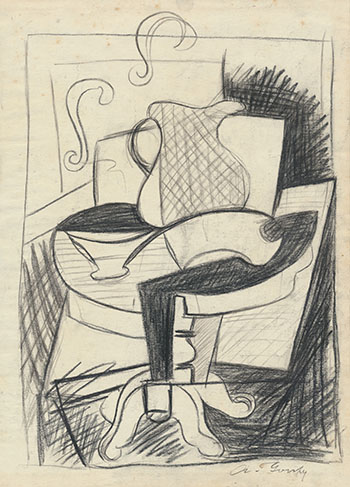 |
Date:
Circa 1934
Title:
Art Arshile Gorky. Still Life. Circa 1934. Graphite on paper.
7.5" x 10.75."
Description: Many of the same
elements fount in Arshile Gorky the Early Years,
Lader, 2004, can be found in this drawing. Shapes are fluid, yet
at times defined. Stamped on verso: “...Galleries, 1016 Madison
Avenue, New York, N. Y. 100...” Signed lower right: “A. Gorky.”
Acquired from a collector in Asia.
Size:
7.5" x 10.75"
S#:
1934.01.0822 |
|
|
|
|
Arshile Gorky: Study of "STILL LIFE." |
|
|
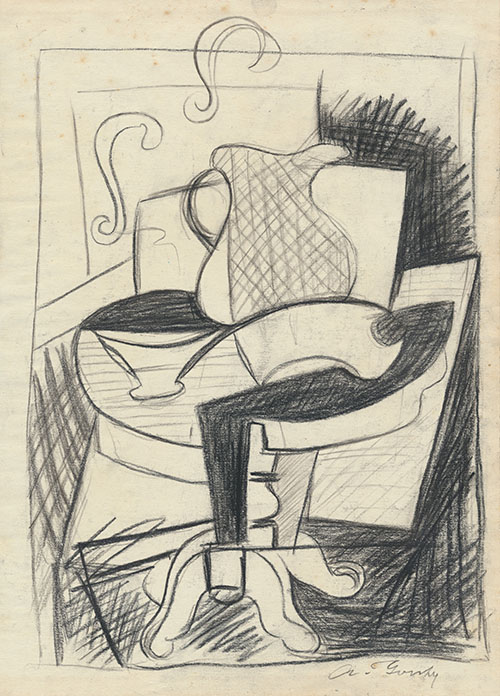 |
|
|
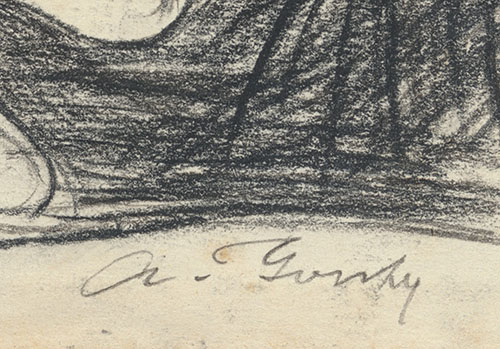 |
|
|
|
|
|
|
|
|
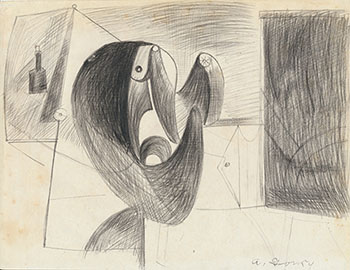 |
Date:
1935
Title:
Arshile Gorky. Untitled. Circa 1935.
Description: Graphite on paper. 9.75 x 7.5." Very
similar to a work published in Arshile Gorky Three Decades of
Drawings, Lader, 1990, Plate 20. Signed lower right: “A. Gorky.”
Stamped on verso within a box: “Musee Fernand Leger, Biot.” The
Fernand Léger Museum, is a French national museum in Biot, in
south-eastern France. Acquired from a collector in New York
City.
Size:
9.75" x 7.5"
S#:
1935.01.0223 |
|
|
|
|
Arshile Gorky: Study of "UNTITLED." |
|
|
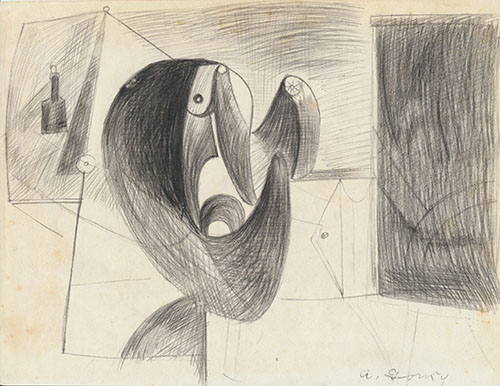 |
|
|
 |
|
|
 |
|
|
|
|
|
|
|
|
|
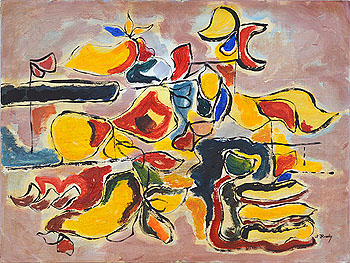 |
Date:
Circa 1943
Title:
Arshile Gorky. "Untitled." Circa 1943. Oil on canvas. 24 x 18".
Description: Similar in style to "Garden of
Sochi" 1943, and "Waterfall" ca 1943. Here, Gorky creates fluid
biomorphic shapes, almost organic in nature. Hints of .abstract
flowers, plants and landscapes. Colors are strong and dynamic.
Layers upon layers, creating depth. Strokes are laid down as
solids and washes. Shapes are defines with black outlines.
Signed lower right: "A Gorky." Stamped on frame: "Anco Bilt"
(within an artist’s pallet), "Glendale NY" and "24." And "Anco
Bilt" (within an artist’s pallet), "Glendale NY" and "18."
Size:
24" x 18".
ST#:
1943.01.1118 |
|
|
|
|
Arshile Gorky: Study of "Untitled." |
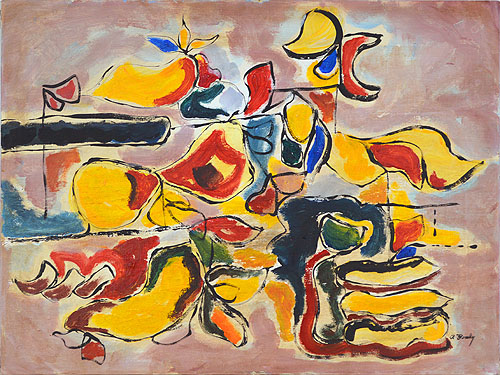 |
|
|
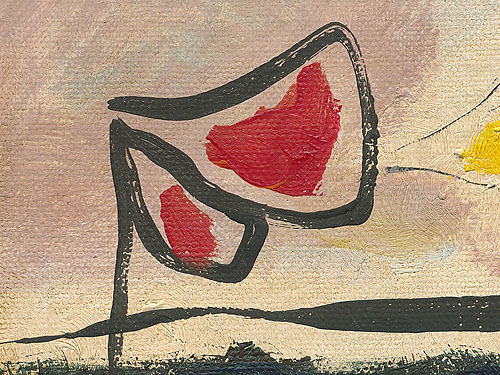 |
|
|
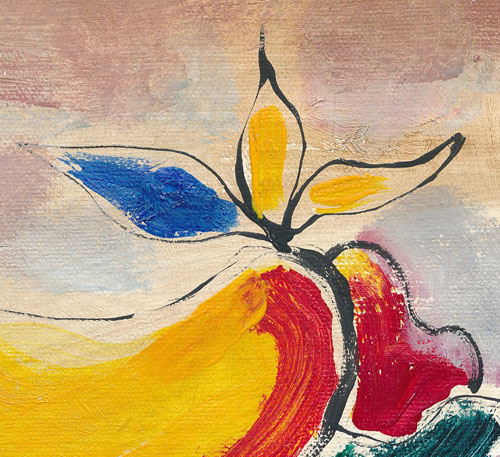 |
|
|
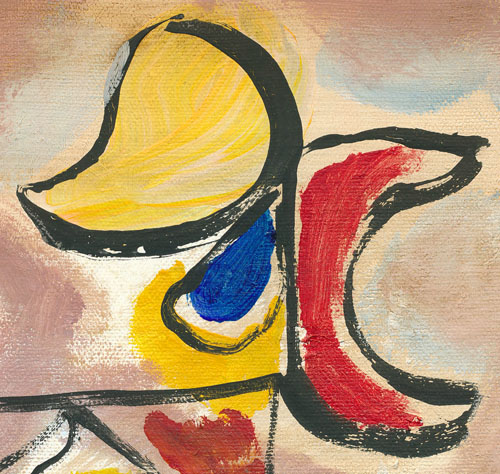 |
|
|
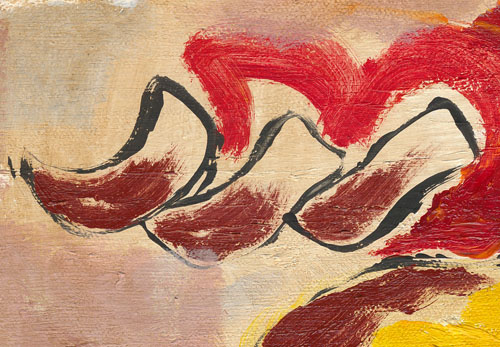 |
|
|
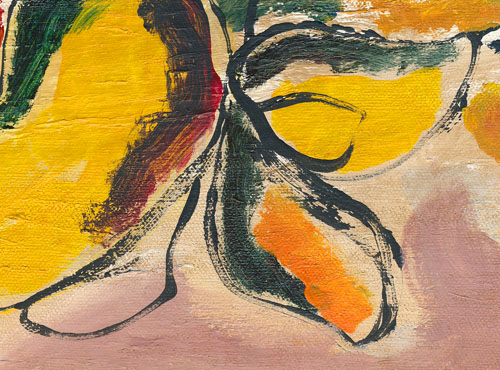 |
|
|
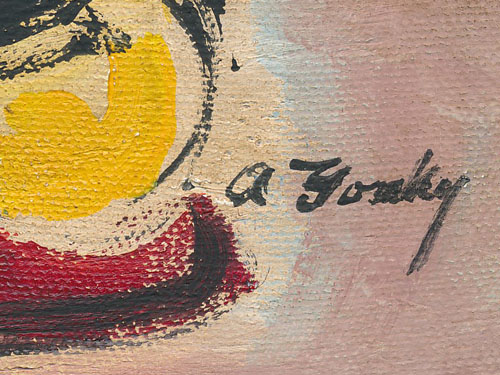 |
|
|
|
|
|
|
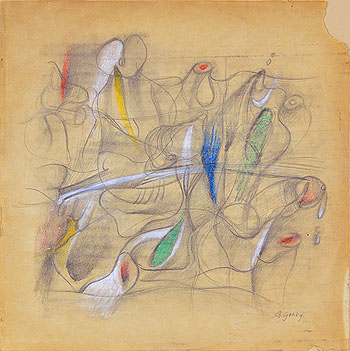 |
Date:
Circa 1944
Title:
Arshile Gorky. "Untitled." Circa 1944.
Description: Pencil and crayon or pastel on
paper. 12 x 12." Similar in style to: "Landscape - Virginia,"
1945, and other untitled drawings circa 1943 - 45. Gorky creates
fluid shapes, almost organic in nature. Hints of abstract
flowers, plants and landscapes. Drawn in pencil, shading in
pencil with crayon or pastel accents. Signed lower right: "A.
Gorky."
Size:
12 x 12."
ST#:
1944.01.0119 |
|
|
|
|
Arshile Gorky: Study of "Untitled." |
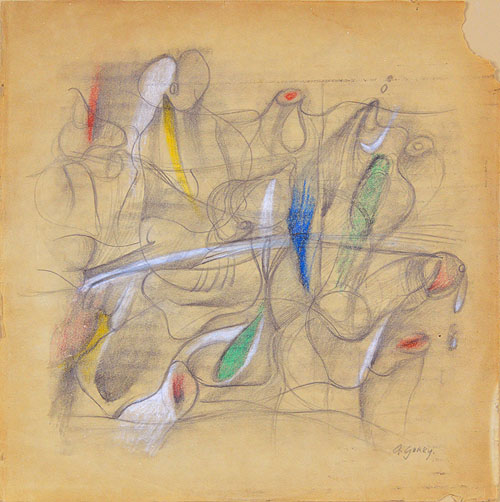 |
|
|
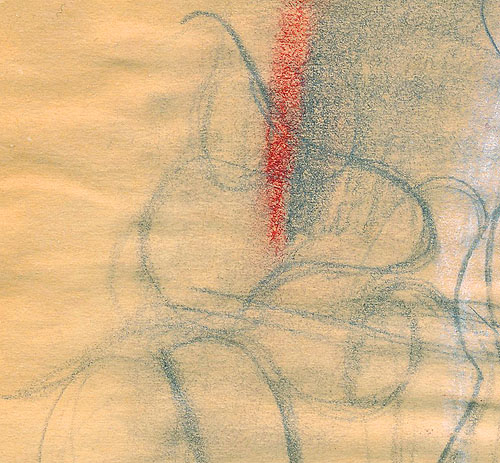 |
|
|
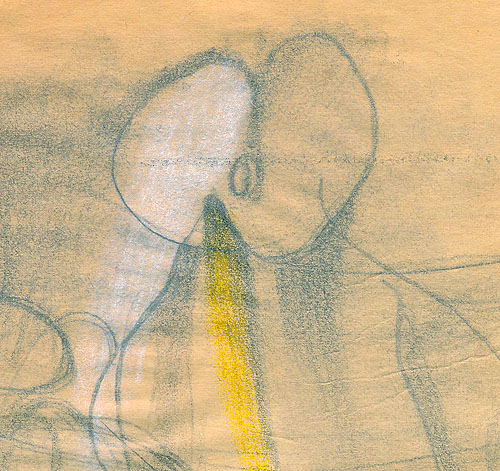 |
|
|
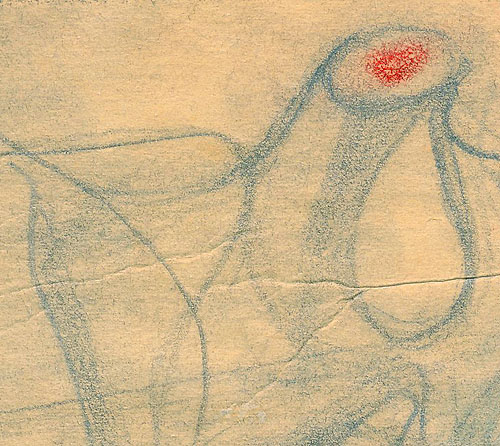 |
|
|
 |
|
|
 |
|
|
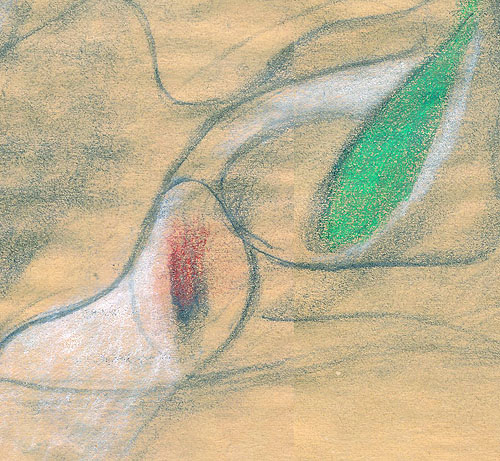 |
|
|
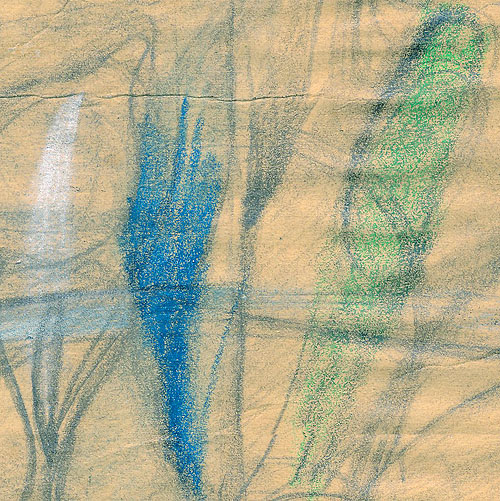 |
|
|
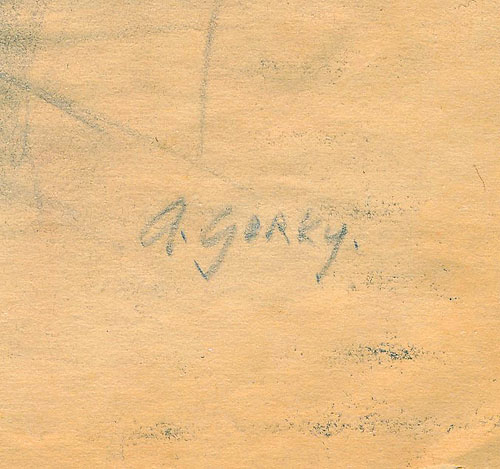 |
|
|
|
|
|
|
|
|
|

CLICK TO ORDER

























































